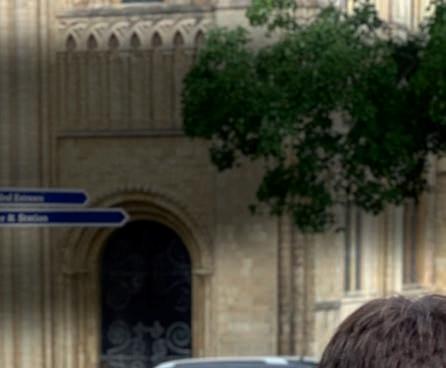
12 minute read
Looking the Future In The Eye: Mergers & Acquisitions A source of
LOOKING THE FUTURE IN THE EYE: MERGERS AND ACQUISITIONS
Effective management of the strategic direction and development of schools has never been so critical as in today’s COVID-impacted world. Barney Northover and Kenji Batchelor from law firm VWV offer some thoughts on how mergers and acquisitions can provide shelter to some schools and innovative and attractive solutions to others.
Much has been made of C acting as both disruptor and accelerator. Since March 2020, independent schools have changed and adapted in ways we would have previously thought impossible. They have navigated their way through multiple loc downs, delivered remote teaching and met new regulatory re uirements. nd, all the while, they have sought to balance their boo s in many cases, in the short term, introducing temporary fee discounts and ma ing use of the furlough scheme. ut notwithstanding the hope offered by the arrival of effective vaccines, more challenges lie ahead. The impact of the recession on pupil rolls remains un nown.
This means difficult decisions on T will need to be made. The threat of tax changes lingers as politicians seek to balance the nation’s finances. rexit will also have an impact on the ’s relationship with mar ets. The issue of the affordability of education in the sector also continues to loom large. Schools need to remain vigilant and manage their situation carefully.
Changing with the times
chools have always needed to change with the times in response to shifting demand for, and supply of, an independent education. There have always been mergers, acquisitions and disposals of schools and there are a very many success stories. ven before the financial difficulties induced by the C crisis, it was increasingly seen as a good strategy to join with other schools within a group.
We have seen this in the state sector, where academies have been encouraged to federate in ulti cademy Trusts, and in our own sector we have seen the growth of local and national groups of both commercial and charitable schools. One of the drivers for this trend is the need to take advantage of economies of scale and offer protection from financial shoc s of the type we are now experiencing.
n the current crisis, many governors and proprietors will now be considering whether their school should join with others. This could be either to ensure their own survival or to offer shelter and protection to other schools, particularly those which are feeders or complement their own school’s educational mission.
Why and when to consider a merger or acquisition
The decision to consider a merger, acquisition or disposal can be one of strategic opportunity or a solution to a challenge. One key message in this article is to undertake a ‘health-check’ on the school. This may uncover different drivers for schools to consider when contemplating strategic change of this nature. Such drivers can include: • over-supply of school places in your area as a result of demographic changes • competition from other independent schools or the state sector • under-investment in previous years • rising costs and the need to realise economies of scale • retirement of key staff • parental demand for a wider curriculum, more facilities, co-education, a wider age range, or simply for a larger school • affordability challenges and downward pressure on fees If there are warning signs, the key is to act on them early. Get to know the market. Understand local and national demographics. Recognise economic trends and set realistic expectations on projected pupil numbers and income. In the case of proprietary schools, be aware of looming succession issues.
It takes courage for leaders and governors to initiate the conversation, but it is a wise school that looks at the area it serves and determines that, being absolutely objective, if competing local schools combine, they may be better placed to meet the needs of the community and secure their long-term future, albeit in another form. A similarly difficult conversation about the status of a school – in particular whether a charity remains best-placed to operate a school or whether a for profit operator may be better placed to take it forward – may be necessary to ensure the future success and longevity of a school.
Unfortunately for some, the pressure and pace of change will leave little option but face permanent closure, but it should be a last resort having considered all other routes – including mergers, acquisitions and other strategic projects – first.
How to prepare
nce a school has identified its strengths and weaknesses and decided it is in its best interests to explore strategic opportunities, we would recommend that the leadership team contemplating a merger, acquisition or disposal take


independent professional advice, including from lawyers, accountants, surveyors and PR advisers.
You should also draw up a descriptive profi le of the school and identify clear objectives and benefi ts which are sought from a merger, acquisition or sale. It can be helpful to seek professional support if you need a ‘match-making’ go-between.
When you have a prospective school partner or partners in mind, an early action should be to draw up a feasibility study which: • assesses the present fi nancial position of each school and, in particular, the level of debt and other liabilities • identifi es future demographic, social and market trends • provides an initial view of how complementary the cultures of the prospective partner schools may be, including senior management teams, common rooms and parent bodies • considers the composition • considers the composition of the new Governing body • assesses the pupil roll of each school at the present date and sets a realistic fallout rate that can be withstood



How it might look
A wide range of business models might be contemplated, each involving different levels of complexity. For example, if schools combine together in a group where each is operated as a separate business under operated as a separate business under common ownership within a family of common ownership within a family of schools, there may be minimal schools, there may be minimal day-to-day impact on staff, parents and pupils. On the other hand, the merger of two schools on a single site will inevitably be more emotive and involve greater upheaval for the stakeholders.
There are also differences between commercial transactions and charity mergers. In an acquisition/disposal, one party (the ‘Buyer’) will acquire from the other (the ‘Seller’) the target school’s assets for a price. On occasions, an acquisition may take the form of a share sale.
Even between charities, ‘merger’ is often a euphemism for ‘take-over’; invariably one of the merger partners will be more dominant in terms of size, control, asset value, geographical position, market strengths or some other key factor.
The legal considerations for a charitable merger and a school acquisition are quite different in terms of the approach, timetable, structure and legal processes. There are, however, similarities in the practical approach required.
Initial discussions
Initial discussions are likely to be at a Chairman-to-Chairman level. Before proceeding beyond this stage, the parties should enter into a Confi dentiality Agreement and an Exclusivity Agreement. The former will ensure that the discussions themselves – plus any commercially sensitive information released during the due diligence process – remain confi dential. The latter will ensure that the negotiations are exclusive of others.
Once the parties have reached broad agreement, they should enter into Heads of Terms which set out the agreed commercial terms and the proposed legal structure. Parties to a merger of charities should consider, negotiate and agree a Memorandum of Understanding which sets out a number of ‘soft issues’ in relation to the future operation of the merged school, such as its ethos, etc.
Due diligence
Due diligence is a vital step in any transaction. It is a process undertaken in order to fi nd out as much about the other party as possible in order to assess whether suffi cient ‘value’ exists to justify proceeding. It is also designed to ascertain whether there are any hidden liabilities and identify matters requiring further investigation. Ultimately, the exercise will determine whether or not to proceed.
In the case of a merger between two charitable schools the due diligence process should be ‘two way’. Each party will want to fi nd out as much about the other as possible: one party will require some certainty that the assets of the ‘target’ school comfortably exceed its liabilities and the other party will want to be sure that it is transferring assets to an
TOP TIPS
Know your school
Be clear-thinking and realistic about what kind of merger it is. The parties should agree whether respective strengths can be preserved and weaknesses shed.
Know your market
Be clear about the extent of market demand for the merged school.
Take parents and staff with you
Ensure that there is support and commitment from parents and staff; this must never be taken for granted. Have a common vision
Form a clear picture of how the merged school will look at an early stage. Once the vision has been shared and agreed between parties, it becomes much easier to discuss matters of detail.
Be realistic about the cost
Undertake a sensible analysis to be reasonably confi dent that the shortterm fi nancial and management burden will be outweighed by longer-term benefi ts.
undertaking that is viable and commercially sound. In addition, an investigation will need to be undertaken to ensure that the merger is possible under charity law.
In the case of an acquisition, the process will be ‘one way’ (only being undertaken by the Buyer on the target school) and will be used to assess whether it is paying a fair price. If, having undertaken the process, the Buyer discovers facts or circumstances that cause it concern, it may seek to include specifi c provisions in any contract by means of warranties, indemnities and or fi nancial retentions) to provide it with protection. Or it may seek a reduction in the purchase price.
Once the agreed conditions have been met (these are likely to include DfE consent and TUPE consultations and possibly Charity Commission approval), legal completion can take place and the legal title in the assets will be transferred. agreed in the Heads of Terms or Memorandum of Understanding. There is different terminology for this agreement which may be an Asset Purchase Agreement or Share Purchase Agreement in the case of an acquisition/disposal and a Merger Deed or Merger Agreement in the case of a merger between charities.
At a suitable point, provided that the documentation has been agreed, the documentation has been agreed, the legal agreement can be exchanged subject to a number of conditions. In our experience this is the best time to announce the merger as the deal has already been ‘done’ and cannot readily be unravelled. Resource pack
Transactions between schools have become common in the independent school sector but nevertheless many school leaders will only be involved in such a project once.
To help schools navigate the path and avoid the traps, VWV has worked with the ISC associations to produce a resource pack with more than 50 pages of guidance, checklists, timetables and templates. The pack was last updated in October 2020 to account for the challenges of the COVID crisis and is available free of charge from the ISC, your school associations or from VWV. ●
BARNEY
NORTHOVER is a Partner at VWV (email: bnorthover@ vwv.co.uk or mobile: 07973 423 081) KENJI
BATCHELOR is a Senior Associate. (email: kbatchelor@vwv.co.uk or mobile: 07384 251 898).
Communication and PR
A good communication strategy is one of the key critical factors in determining the success of the merger. It is essential that the Head, governors or proprietor present a consistently positive outlook to staff, parents and pupils in order to ‘win hearts and minds’. The success of a merger can be jeopardised if the positions of parents, pupils and staff are not properly considered and addressed. We recommend appointing a specialist public relations consultant to assist in developing and promoting positive key messages about the merger.
The legal agreement
A legal agreement will need to be prepared to re ect the s eleton terms



Gold Standard Testing Gold Standard Testing for Independent Schools for Independent SchoolsAbout Password “Password provides us with an efficient and Password provide high quality English language and Maths reliable way of assessing the Maths ability of reliable way of assessing the Maths ability of testing for universities, schools and colleges. Over 400 institutions international students on application, allowing us international students on application, allowing us utilise our academically world-leading assessments under their own control and brand. Every year our tests are taken in more utilise our academically world-leading assessments under their own control and brand. Every year our tests are taken in more to accurately assess their suitability for a particular course and advise them accordingly.” to accurately assess their suitability for a particular course and advise them accordingly. than 150 countries worldwide. than 150 countries worldwide. Mike Campbell, Head of Maths, Felsted School, Essex. Password Pupil tests are secure and simply managed online. They allow schools to accurately assess international pupils whilst still delivering fast results which can reliably inform Password Pupil tests are secure and simply managed online. They allow schools to accurately assess international pupils whilst still delivering fast results which can reliably inform Discover why schools are adopting Password Pupil tests at these upcoming virtual events: tests at these upcoming virtual events: admissions decisions and teaching arrangements. admissions decisions and teaching arrangements. British Council International Education Virtual Fair What our partner schools say: 18th – 21st January 2021. “Password Pupil has given King’s Ely a single platform testing management system for years 6 – 13 for all our international management system for years 6 – 13 for all our international COBIS Professional Development Webinar 20th January 2021. COBIS Professional Development Webinar applicants. The content is rigorous, valid and randomly applicants. The content is rigorous, valid and randomly AMCIS/IAPS Prep School Marketing Connect: Showcase AMCIS/IAPS Prep School Marketing Connect: Showcase generated and managing the system has proved simple with generated and managing the system has proved simple with 27th January 2021. excellent customer support from the excellent customer support from the British Boarding Schools’ Network Webinar British Boarding Schools’ Network Webinar
Password team.”Password team. 28th January 2021. Matthew Norbury, Academic Director of International British Boarding Schools’ Workshop Virtual Event British Boarding Schools’ Workshop Virtual Event Programmes, King’s Ely, Cambridgeshire Programmes, King’s Ely, Cambridgeshire 3rd – 5th March 2021.


For more information, see our website: www.englishlanguagetesting.co.uk or email: For more information, see our website: www.englishlanguagetesting.co.uk contact@englishlanguagetesting.co.uk contact@englishlanguagetesting.co.uk










